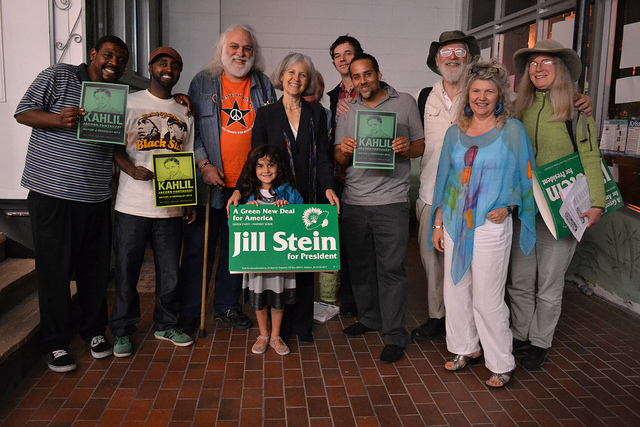Jill Stein, the Green Party’s candidate for the presidency, earned just shy of 400,000 votes Tuesday, putting her in fourth place. Had all of those votes been in one state, Stein could have earned a maximum of four electoral votes in a state like Maine or New Hampshire. The last time 400,000-some votes would have actually won the office was 1824, though Stein would not have been able to vote for herself.
Stein’s candidacy — like those of the candidates for the Libertarian Party or the Peace and Freedom Party, or that of Santa Claus — accomplished one thing: reinforcing that third parties are a joke. That they are not even tangential to the political discussion, because “tangential” implies touching. Third parties are asymptotic to the American political conversation. For all of the (fair) arguments that the system is rigged against third parties, it is also true that third parties are not interested enough in being taken seriously to do the hard, grueling work it would take to actually build a political movement.

greendoulaJill Stein campaigns in the battleground of Berkeley, Calif.
Perhaps the high-water mark for Stein’s candidacy was the alternative presidential debate moderated by Larry King. Over the course of that meandering 90 minutes, hosted on the Russian-government-funded RT network, Stein chose to focus on her plan to create 25 million green jobs. That’s a number almost 10 times the Brookings Institution’s assessment of the size of the sector today; it is twice the number of people who are actually unemployed. It’s a laughable idea. But the beauty of the debate was that such surreal political ambition went completely unchallenged. Each candidate could present his or her own ideal, unattainable world to the viewers, and the viewers could nod along and say, “Oh yes, that sounds nice, no drones, more weed,” and then the debate was over.
Third-party presidential campaigns are like asking a toddler what he wants to be when he grows up. Or, better: what he wants for Christmas. Sky’s the limit. The shackles of reality that bind the rest of us and limit conscientious politicians on Capitol Hill just slip off of wispy arms. Third parties are to politics what Christian rock is to music: Maybe they’d be good if they just took their foot off the accelerator every once in a while. But, driven by a righteous desire to convert everyone to their worldview, it’s the same lyrics to different melodies for song after song after song. That gets boring. And it turns people off.
What third parties — and particularly the Green Party — could do is obvious. There are a number of states that have open primaries or allow candidates to run under multiple party designations. Places like California, Minnesota, New York. The party needs to leverage that flexibility, those cracks in the monolithic two-party system, to establish a toehold. A number of toeholds. Because national politics, with its massive expense, is a popularity contest. And there’s only one way to win a popularity contest: become popular. If the Green Party built relationships with local elected officials, lured them to first share the Green Party appellation and, eventually, assume it, they could establish a meaningful local presence. Build a reputation as a party and for its candidates. Advocate for changes in other states and regions to crack the duopoly. Over the course of many years, build from a local opportunity into a regional force. And then to Washington.
This is a slow, expensive, difficult proposal. It’s one that has been and is being tried by other third parties, like New York’s Working Families Party. The Working Families Party has built a base of support by running fusion candidates (candidates that run for multiple parties at once) and partnering with organized labor. Meanwhile, here’s the New York Green Party’s attitude to fusion candidacies:
“We intend to elect Greens with votes on the Green Party line. We are not another ballot line for the other parties. We are different. We are the alternative. We are challenging the two major corporate-funded parties as well as the minor parties that are satellites of the corporate parties through the practice of fusion,” said Howie Hawkins, a co-chair of the Green Party and its 2010 gubernatorial candidate.
“We believe our political independence builds more power to advance our policies than helping to elect the candidates of other parties. Running our own candidates makes the candidates of the other parties compete for Green votes. That gives us far more power to set the policy agenda than giving our votes away to other parties through fusion,” Hawkins added.
The only thing stupider and more naive than this attitude — this failure to take advantage of one of the few minute opportunities for third parties — is the other announcement in that same bulletin. The Green Party is adopting as its logo the peace symbol. Way to stay on message.
It’s extremely hard to grow to scale even locally. It takes money and focus and savvy. Above all else, it means compromise: shared priorities and acquiescence on core issues in order to build a movement. Which is why it will never happen. Third parties don’t want to be establishment parties, they want to be flamethrowers. They operate under the delusion that one last jolt to the system will cause the whole thing to fall into their laps. Good luck with that.
To be taken seriously, the Green Party needs to grow up, do some hard work, build for the future. It won’t. So don’t take it seriously.



